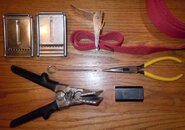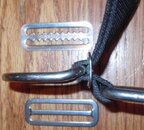- Messages
- 7,660
- Reaction score
- 4,717
- # of dives
- 200 - 499
Looks like a lot of divers are currently re-webbing harnesses. I found this to be a frustrating task the first time I tried it. Done it many times, got better at it with each try. I'll share my tips. Please add yours...
The Malco sheet metal tool (Home Depot) is the very best thing that I have found for finishing the melted edge of nylon webbing. Use a CIGAR lighter to melt the frayed edge then squeeze with the tool. If you just melt the edge it will cool and harden wider than the webbing and you will really work at getting it through double slots. Use a pair of needle-nose pliers to "roll" the inside loops when you are tightening everything up. The pin (or an awl with a very rounded end) is great for loosening / repositioning webbing.

Note the two "depth-compensating" buckles, the slot pattern is different. Shown is the way to web a three slot buckle. It isn't immediately obvious if you have never done this yourself.
Triglides come in two common styles, single-wide slot with teeth and double-wide slot with no teeth. Use the ones with teeth for keeping hard weights on a weight belt, use the other triglides as shown below:

Above is a D-ring on a pentagonal ring (for a chest strap). I don't use that config any more...
The Malco sheet metal tool (Home Depot) is the very best thing that I have found for finishing the melted edge of nylon webbing. Use a CIGAR lighter to melt the frayed edge then squeeze with the tool. If you just melt the edge it will cool and harden wider than the webbing and you will really work at getting it through double slots. Use a pair of needle-nose pliers to "roll" the inside loops when you are tightening everything up. The pin (or an awl with a very rounded end) is great for loosening / repositioning webbing.

Note the two "depth-compensating" buckles, the slot pattern is different. Shown is the way to web a three slot buckle. It isn't immediately obvious if you have never done this yourself.
Triglides come in two common styles, single-wide slot with teeth and double-wide slot with no teeth. Use the ones with teeth for keeping hard weights on a weight belt, use the other triglides as shown below:

Above is a D-ring on a pentagonal ring (for a chest strap). I don't use that config any more...




